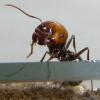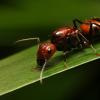I've asked a myrmecologist and another entomologist about it and they both advised me to not release alates from my colonies, even if the colonies were started with queens captured locally. The myrmecologist told me a story about frogs - there was a case of reintroduction of captive bred frogs into an area which had its natural population of the species in poor condition. Unfortunately it turned out the captive kept frogs were incubators of some sort of disease/parasite, which did not kill them in captivity, but did once exposed to harsher natural environment. It took the wild frogs with them too... The story was just mentioned, so I can't find any studies on that exact case, I don't even know the species of the frog, but the conclusion was - my home environment is making survival for my ants easier than in nature, so they potentially can be incubators of diseases. The diseases can be ant affecting or affecting a different part of the food chain (birds eating the alates, for example). There also come problems related to the colony being of a species native to the country, but not being started from a locally captured queen (for example, you bought a Lasius niger queen from a store, but it comes from a place 400 km away from you), causing disturbance in local gene pool. Or the fact I also keep exotic species, so potentially some exotic fungus/virus could be transmitted to my local ants. There are so many variables which are a very low chance, but still non-zero chance of causing a problem, so the conclusion from both consulted people was:
Don't release alates from your colony, period.
So I hunt them down one by one with tweezers when they attempt flying in the outworld. It's a tedious job and some do escape while the net is lifted, but that ensures the alates leave the nest. I don't think a frustrated princess would eliminate the rightful queen, but I fear that later I won't know which queen is real and will get trolled by a dead queen in the outworld. Unfortunately, in case of my Camponotus fallax, some queens have lost their wings and are now performing major workers role. They usually are filled with food to the brim. The real queen doesn't get that fat
https://imgur.com/gallery/mnT30YD
https://imgur.com/a/KtXD0ZY
Edited by Kowal, April 17 2024 - 12:30 PM.


















